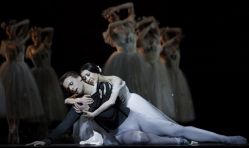Giselle: a woman of depth

Ravenous applause greeted the opening performance of *Giselle* last night and the final production for prima ballerina Chan Hon Goh. Leading the "National Ballet of Canada":http://www.national.ballet.ca/, which has been her home for 20 years, Goh was a revelation in the majestic Four Seasons auditorium. Her dancing was sublime, as it has been throughout her dazzling career. But her dramatic power continues to evolve and engulf the stage.
It’s been 14 years since Goh left behind the anonymity of the National Ballet corps and became a principal dancer, personally coached by legend, now artistic director, Karen Kain. There is no consolation for seeing her leave the stage, except perhaps seeing her dance this tour de force role one last time. Giselle sweeps the stage for five more shows, but only one more will feature the irreplaceable Goh. Sunday’s matinee is sold out, but maybe the ushers will have pity and invent a standing room for this, the finale of a sparkling career.
*Giselle* has been a staple in the National Ballet’s classical repertoire since its 1970 debut. The shattering story of love, betrayal and forgiveness has wrenched hearts since it premiered at the Paris Opera Ballet in 1841. Sir Peter Wright brought the story new depth with his choreography in 1965, and it has never been more powerful than now, when the haunting story gains new poignancy in Goh’s enigmatic performance.
Sets and costumes designed by Desmond Heeley provided the perfect, unobtrusive ambiance – from idyllic woods and a sweet peasant home in Act I to the erie grave site, full of haunting mist and shadows in Act II. What little light is in that wood reflects off the delicate ghosts of girls betrayed by their loves, the gozzamer-clad Wili. Courtiers’ costumes exude bounty tiptoeing the border between luxury and confinement, while villagers’ garb evokes the Romantic image of peasant life. Calf-length tutus and tight bodices show off dancers’ movements to full advantage, while hunters’ attire adds an edge of masculinity to the men’s image.
That edge especially suits Giselle’s fiancé, Hilarion, played with raw devotion by principal Piotr Stanczyk. His unrequited love for Giselle quickly becomes jealousy, and rough possession takes over his movements. In Act II, he is tortured to death by the sadistic Wili, led by Heather Ogden, whose portrayal is regal in its cruelty. Hilarion’s frenzied dance shows such pained exhaustion with his grief, it’s no wonder it kills him.
National Ballet principal Zdenek Konvalina dances an enthrallingly complex Albrecht, which he will repeat at the Saturday and Sunday matinees. He dodges his nobility as if paralysed by it. In the escape he finds as a pretend-peasant, he radiates desire in his entrancement with Giselle. When his fiancée, Bathilde played with fitting haughtiness by Alejandra Perez-Gomez, reveals their engagement, his betrayal brings to light another aspect – a selfish or simply naïve, spoiled boy. Giselle dies in his arms, and his cowardice is stripped bare, as he runs from his grief. Act II introduces a more sympathetic Albrecht, a man tormented by guilt and haunted by the loss of his love. In any other show, the fevered passion of his steps – sautées and beats of supernatural height and speed - would banish the gloom of the ghostly wood. But in this show, there is no light and no thought for anything but Goh.
Dance commentator Penelope Reed Doob called Chan Hon Goh in her early years, “nine parts hummingbird to one part giggle.” Having watched the corps dancer become an incomparable principal, she revised her statement to “nine parts hummingbird, one part steel.” There is no part of Goh’s fragile-looking body that is not completely controlled by her sharp mind. Her devotion to dance could not be better showcased than in this enigmatic role. Within two acts, Giselle evolves from a light-hearted girl, brimming with bashful excitement, to a wilful woman who chooses her love over family and the familiar. In this, her dancing is pristine, as always. She moves as if weightless, so quickly the eye cannot follow her feet in its beats and turns. Every gesture , even in the simple act of plucking flower petals, radiates inimitable grace. But beyond that grace, and the muscle control and sheer strength it takes to execute, Goh is an impregnable actress. The sequence of airy steps - ballonnes, piques and pas de basque – evokes new emotion every time she dances it. When she is betrayed, she is stricken as sharply with grief as with the blade she drives into her chest. The girlish face that expresses sweet trust in Act I turns to frenzied anguish, then blank insanity. She dances at first with total purity, then masochistic abandon; radiating grace in both. The flexibility of Goh’s body and dramatic expression allow her to transform Giselle from the sweet heroine to a woman damned. Her suicide commits her to the ranks of the Wili, where she seems impossibly light, even for a ghost. While it is haunting, her mere stance, unmoving before Albrecht, expresses desire, love and the pain of not being with him. The redemption she finds in protecting him is one of the most beautiful moments in ballet, made all the more so by Goh’s soulful performance.
This masterful dancer is better than the iconic ballerina, as she’s so often called. She is a woman of depth, blessed with the talent and trained with the skill to communicate every shade of human experience on stage. Even her curtsies, turned from polite formula to the most heartfelt expression of gratitude, are a wonder to watch with her serene radiance.
_Giselle, produced by the National Ballet of Canada runs until May 31 at the Four Seasons Centre for the Performing Arts. Goh will only be performing on one more occasion, the Sunday matinee. For more information go_ "here":http://www.national.ballet.ca/performances/season0809/giselle.php



